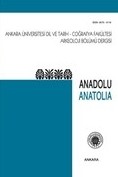
Anadolu
Yazarlar: Murat DURUKAN
Konular:-
Anahtar Kelimeler:-
Özet: The first tendencies of epigraphy and art in Greek manner appear during the Hellenistic period within the Olbian priesterly dynasty in eastern Rough Cilicia. Furthermore a Greacization has taken place in the culture of the region. The effects of this time period which can be defined as acculturation can be observed best on religious platforms. As a result of syncretizm, gods of Luwian origin were Gracesized and the effects of the changes left important traces, not only in epigraphy or artifacts but also in cultural and social spheres. For example the Olbian symbols which are the products of this period are the attributes of Greek gods and can be presented as one ofthe best evidences ofthis influence. It is also obvious that during this period the architectural characteristics of the Olba region changed radically. In the region where no monumental architectural existed until the 3rd century BC, a construction period started through the middle of the 3rd century BC. and flourished in the 2nd century BC. These dates coincide with the important changes observed in epigraphical, social and cultural spheres as well as in art. The most chracteristic feature of this construction period is that the technique of polygonal walls found its way to Olba and started to be used dominantly. Especially the development considering epigraphy, art as well as social and cultural activities which appeared as a result of Graecization make us think that also the architectural development followed the same way. This situation must be the product of a power, willing to settle the Greek culture in Olba and ofa systematical planning. This power was one ofthe most important kingdoms ofthe Hellenistic period, namely the Seleucids and the system they applied was the policy of acculturation. There is a historical parallelity between the frequency of epigraphic and architectural material in this region and the event of 188 BC. as the western border of the Seleucids was defined as Seleucia. It is obvious that there is a combination between these facts and that the acculturation policy of the Seleucids in Olba gained power during this period. The introduction of the polygonal wall technique and its application on civil and military architecture must be considered as a part ofthis policy. The settlements which are not far from each other are small but posess strong fortification walls and the walls ofthese constructions within these settlements are built in polygonal technique. Due to the different topographical features these settlements have various plans but considered as a whole it appears that they are part of an organised settlement and defense system. Constructions of various aims show local characteristics. Ilellenistic tombs, temples and towers, built close to the settlements, reflect the architectural character of the region. Other structures such as fortification walls, their towers, bastions and houses are the buildings mostly attested within the settlements. It is a common feature that they are all built in the polygonal technique. The defense system consists of independent towers and settlements with grandiose defense walls. This system is set on the shore and continued in north-south direction along vallies and roads so that all the region is taken under safety. The polygonal walls are divided into two main groups according to their contours and surfaces
Dergi editörleri editör girişini kullanarak sisteme giriş yapabilirler. Editör girişi için tıklayınız.